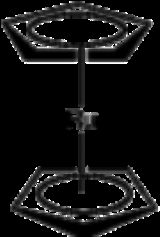
Ruthenocene
Encyclopedia
Ruthenocene is an organoruthenium compound with the formula (C5H5)2Ru. This pale yellow, volatile solid is classified as a sandwich compound
and more specifically, as a metallocene
.
rings. It features ruthenium centre bound symmetrically to the planes of two cyclopentadienyl rings. It is closely related to the isoelectronic ferrocene
.
In contrast to ferrocene, wherein the cyclopentadienyl rings are in a staggered conformation, those of ruthenocene crystallise with an eclipsed conformation. This difference is due to the larger ionic radius of ruthenium, which increases the distance between the cyclopentadienyl rings, decreasing steric interactions and allowing an eclipsed conformation to prevail. In solution, these rings rotate with a very low barrier.
, a Nobel laureate
who had collaborated in assigning the structure of ferrocene only a year earlier. Originally, ruthenocene was prepared by the reaction of ruthenium trisacetylacetonate with excess of cyclopentadienylmagnesium bromide.
Ruthenocene may also be prepared by the reaction of sodium cyclopentadienide
with "ruthenium dichloride" (prepared from ruthenium metal and ruthenium trichloride in situ).
Ruthenocene has been investigated as a photoinitiator for polymerization reactions.
Sandwich compound
In organometallic chemistry, a sandwich compound is a chemical compound featuring a metal bound by haptic covalent bonds to two arene ligands. The arenes have the formula CnHn, substituted derivatives and heterocyclic derivatives...
and more specifically, as a metallocene
Metallocene
A metallocene is a compound typically consisting of two cyclopentadienyl anions bound to a metal center in the oxidation state II, with the resulting general formula 2M. Closely related to the metallocenes are the metallocene derivatives, e.g. titanocene dichloride, vanadocene dichloride...
.
Structure and bonding
Ruthenocene consists of a ruthenium ion sandwiched in between two cyclopentadienylCyclopentadienyl
In organic chemistry, cyclopentadienyl is a cyclic group of atoms with the formula C5H5. Cyclopentadienyl are closely related to cyclopentadiene. Cyclopentadienyl have five carbon atoms bonded together in a pentagonal planar ring, all five of which are bonded to individual hydrogen atoms...
rings. It features ruthenium centre bound symmetrically to the planes of two cyclopentadienyl rings. It is closely related to the isoelectronic ferrocene
Ferrocene
Ferrocene is an organometallic compound with the formula Fe2. It is the prototypical metallocene, a type of organometallic chemical compound consisting of two cyclopentadienyl rings bound on opposite sides of a central metal atom. Such organometallic compounds are also known as sandwich compounds...
.
In contrast to ferrocene, wherein the cyclopentadienyl rings are in a staggered conformation, those of ruthenocene crystallise with an eclipsed conformation. This difference is due to the larger ionic radius of ruthenium, which increases the distance between the cyclopentadienyl rings, decreasing steric interactions and allowing an eclipsed conformation to prevail. In solution, these rings rotate with a very low barrier.
Preparation
Ruthenocene was first synthesized in 1952 by Geoffrey WilkinsonGeoffrey Wilkinson
Sir Geoffrey Wilkinson FRS was a Nobel laureate English chemist who pioneered inorganic chemistry and homogeneous transition metal catalysis.-Biography:...
, a Nobel laureate
Nobel Prize in Chemistry
The Nobel Prize in Chemistry is awarded annually by the Royal Swedish Academy of Sciences to scientists in the various fields of chemistry. It is one of the five Nobel Prizes established by the will of Alfred Nobel in 1895, awarded for outstanding contributions in chemistry, physics, literature,...
who had collaborated in assigning the structure of ferrocene only a year earlier. Originally, ruthenocene was prepared by the reaction of ruthenium trisacetylacetonate with excess of cyclopentadienylmagnesium bromide.
- Ru(acac)3 + 3 C5H5MgBr → Ru(C5H5)2 + 3 "acacMgBr" + "C5H5"
Ruthenocene may also be prepared by the reaction of sodium cyclopentadienide
Sodium cyclopentadienide
Sodium cyclopentadienide is an organosodium compound with the formula C5H5Na. The compound is often abbreviated as NaCp or CpNa, where Cp− is the cyclopentadienide anion. Cp is also used as an abbreviation for the cyclopentadienyl ligand in coordination chemistry.-Preparation:Sodium...
with "ruthenium dichloride" (prepared from ruthenium metal and ruthenium trichloride in situ).
Chemical properties
Ruthenocene typically oxidises via two electron change, instead of one. With weakly coordinating anions as electrolyte, the oxidation proceeds via a 1e step.Ruthenocene has been investigated as a photoinitiator for polymerization reactions.

